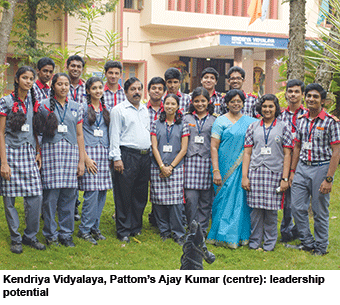EWISR 2015 offers a surprise in the government day schools league table. The previously unranked Kendriya Vidyalaya, Pattom has made a spectacular debut to be ranked #1 this year
 Twenty-first century india’s 1.20 million government-funded schools are sui generis (unique/class of their own) because they are almost completely divorced from the country’s 60 million middle-class households. Whereas in the industrially developed countries of the western world, including the UK, US and Europe, over 95 percent of children attend government schools with only a small elite enroled in private schools, in professedly socialist India, no self-respecting middle class household will send its children to a government school.
Twenty-first century india’s 1.20 million government-funded schools are sui generis (unique/class of their own) because they are almost completely divorced from the country’s 60 million middle-class households. Whereas in the industrially developed countries of the western world, including the UK, US and Europe, over 95 percent of children attend government schools with only a small elite enroled in private schools, in professedly socialist India, no self-respecting middle class household will send its children to a government school.
Moreover, despite most government schools providing free-of-charge primary education with free mid-day meals, textbooks and uniforms thrown in, even bottom-of-pyramid poor but aspirational households make great financial sacrifices to enroll their children in budget private schools. Unsurprising, given that the overwhelming majority of government schools are characterised by crumbling buildings, lack of toilet facilities, drinking water, electricity, and suffer acute teacher shortages, multi-grade teaching and negligible learning outcomes.
But wait, there are exceptions. The inorganic, centrally-planned neta-babu socialist economic development model adopted by the Nehruvian Congress government of post-independence India posited that the privileged nomenklatura of officially modestly-remunerated government employees deserved primary-secondary education equivalent to the best provided by private schools. Thus, the Kendriya Vidyalaya Sangathan (public schools society) was established in 1963 to promote Kendriya Vidyalaya (KV) schools to “cater to the educational needs of the children of transferable Central government employees including defence and paramilitary personnel, by providing a common programme of education”.
Since then, the number of KVs has multiplied to 1,117. These well-funded CBSE-affiliated schools provide high-quality class I-XII education to over 1.1 million students of both sexes. With tuition fees a nominal Rs.500 per month and the Central government spending Rs.27,000 per child in well-equipped KVs (cf. a mere Rs.3,000 per year per capita in state government schools), it’s hardly surprising that KVs dominate the EW government day schools league table with only one state government school ranked in the Top 10.
 However, EWISR 2015 offers a surprise in the government day schools league table. KV-IIT Madras which was ranked #1 last year, has been trumped by the previously unranked Kendriya Vidyalaya, Pattom, Thiruvananthapuram (Kerala) and KV-IIT, Bombay, and relegated to #3 by this year’s sample respondents. Top rated on the parameters of competence and commitment of teachers and sports education, and rated highly on parental involvement and value for money (students pay only Rs.250 per month because of a court order), KV-Pattom has bested other government schools by a comfortable margin.
However, EWISR 2015 offers a surprise in the government day schools league table. KV-IIT Madras which was ranked #1 last year, has been trumped by the previously unranked Kendriya Vidyalaya, Pattom, Thiruvananthapuram (Kerala) and KV-IIT, Bombay, and relegated to #3 by this year’s sample respondents. Top rated on the parameters of competence and commitment of teachers and sports education, and rated highly on parental involvement and value for money (students pay only Rs.250 per month because of a court order), KV-Pattom has bested other government schools by a comfortable margin.
“I am very pleased to learn that KV-Pattom has been ranked India’s #1 government day school. I believe this school, which provides excellent sports facilities with several sportspersons routinely topping national school tournaments and athletics meets, has the best all-round performing students of any school countrywide. They have the potential to emerge as leaders in all walks of life,” says Ajay Kumar, a science and education postgraduate of Kerala University who began his career as a KV teacher in Manipur in 1992 and has since served as principal of KV schools in Mankhurd (Mumbai), Kumbhirgram (Assam), Delhi Cantt, prior to being appointed principal of KV-Pattom which has an aggregate enrolment of 3,965 students, including 1,940 girls mentored by 120 teachers.
The sole state government primary-secondary to make the Top 10 league table of India’s best government schools is also based in Kerala, routinely ranked as the country’s most literate and socio-economically developed state in almost all surveys and studies. The Government Vocational and Higher Secondary School for Girls (GVHSS), Nadakkavu, Kozhikode (estb.1893) has risen in the public esteem to be ranked one notch higher this year at #4. But the steady progress of this all-girls state board affiliated class I-XII school, which has 2,497 students and 82 teachers on its muster rolls, is less attributable to efforts of the state government than to the Dubai based Faizal & Shabana Foundation which gave the school a complete Rs.16 crore makeover in 2014, transforming it into a model government school.
“This has been a good year for GVHSS. Our state board exam results are the best ever, construction of our A.R. Rahman School of Music has commenced and will be completed in one year, and the Faizal & Shabana Foundation’s Mission 100 proposal to establish 100 GVHSS model schools across the state has been cleared by the Kerala government. Against this backdrop, our advancement in the EWISR 2015 government schools league table is a great morale booster. In particular, our #1 ratings on the parameters of infrastructure provision and life skills education is very encouraging,” says Joseph Sebastian, chief executive of the Faizal & Shabana Foundation.



























